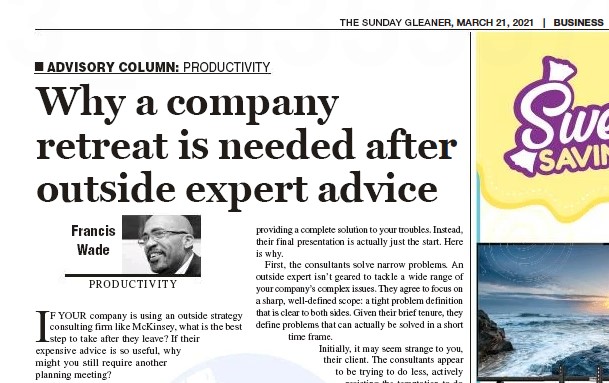Prefer to listen to or view this article?
If your company is using an outside strategy consulting firm like McKinsey, what is the best step to take after they leave? If their expensive advice is so useful, why might you still require another planning meeting?
Many of the most successful companies around the world avail themselves of the research services provided by firms such as McKinsey & Co, Bain & Company and Boston Consulting Group (BCG). Their formula is often the same: a prospective client presents them with a difficult problem. To find solutions, they assemble a team of young, bright MBA’s who tackle the issue in an intense three to four-month sprint. Working long nights and weekends, they delve into their database of past projects and proprietary data, relying on the stellar advice of their global network of experts.
Compared to the internal resources of the typical client, they have an unmatched ability to bring a firehose of assistance to a threatening blaze.
However, don’t believe for a second that they are providing a complete solution to your troubles. Instead, their final presentation is actually just the start. Here’s why.
#1 – They Solve Narrow Problems
An outside expert isn’t geared to tackle a wide range of your company’s complex issues. They agree to focus on a sharp, well-defined scope: a tight problem definition that is clear to both sides. Given their brief tenure, they define problems that can actually be solved in a short timeframe.
Initially, it may seem strange to you, their client. The consultants appear to be trying to do less, actively resisting the temptation to do more. This sometimes lead to tensions. Some look at the huge price-tag (US$1-2 million) and believe that at that level, every issue should be resolved by their high-powered team.
But that’s not how it works, with good reason.
As expert problem-solvers, they operate a bit like surgeons. Within their narrow specialty, they are called into crisis situations to tackle your organization’s issues no-one else can. They represent an immediate investment of time and money to carry out a critical intervention. As such, it’s unprofitable and unwise for them to “boil the ocean”. Their value lies in their ability to go deep very quickly, not to understand a great deal of complexity.
That’s why, when their job is done, they need to walk away. They should never usurp the responsibility for the long-term health of the company. That should remain the primary job of you, the client. Likewise, the implementation of their recommendations should not be in their role.
#2 – Their Solutions Have an Expiry Date
An outside consultant’s advice might be the best possible answer to a given problem…right up until the date their intervention ends. After that, all bets are off.
Case in point: if COVID-19 has taught us anything, it’s the fact that dramatic disruptions do take place. Imagine if, after receiving a consultants’ report, a pandemic were to break out. The unfortunate timing could render the contents meaningless.
This is why it’s critical for clients to act on specific advice immediately, never allowing it to languish. Does this mean that they should rush to implement the suggestions without question?
#3 – Outside Experts Aren’t Your Company’s Primary Strategists
Ultimately, the fact is that consultants can’t understand the entirety of your business in just a few months. This means they shouldn’t become your organization’s chief strategists. That job remains in the executive team, led by the CEO.
Whether their recommendations confirm, deny or augment prior wisdom, your senior managers should consciously incorporate them into their thinking. But there’s a caveat. Not every recommendation they made is worth pursuing. Why? They simply cannot take into account all the factors necessary to lead your business into the future.
As such, the chances of their report being completely correct are low, especially in the areas in which they tend to be weak: cultural differences, human resources and change management. While their technical analysis might be on point, it won’t be perfect.
Turning their findings into something valuable requires some hard, additional work, regardless of the price-tag paid. Your team’s combined wisdom is needed to treat the expert advice as only a single input among many: an element of the organization’s strategic management, but never a replacement.
The final decisions remain in the hands of your executives. They must now plan a complete strategy, short and long term, that builds on the report. The first post-McKinsey meeting is therefore just the start of a new planning cycle, albeit one that has the advantage of some fresh insights.
This article was originally published in the Jamaica Gleaner.

